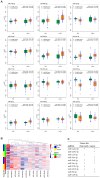miRNAs as Biomarkers for Diagnosing and Predicting Survival of Head and Neck Squamous Cell Carcinoma Patients
- PMID: 34439138
- PMCID: PMC8392400
- DOI: 10.3390/cancers13163980
miRNAs as Biomarkers for Diagnosing and Predicting Survival of Head and Neck Squamous Cell Carcinoma Patients
Abstract
Head and Neck Squamous Cell Carcinoma (HNSCC) is the sixth most common cancer worldwide. These tumors originate from epithelial cells of the upper aerodigestive tract. HNSCC tumors in different regions can have significantly different molecular characteristics. While many microRNAs (miRNAs) have been found to be involved in the regulation of the carcinogenesis and pathogenesis of HNSCC, new HNSCC related miRNAs are still being discovered. The aim of this study was to explore potential miRNA biomarkers that can be used to diagnose HNSCC and prognose survival of HNSCC patients. For this purpose, we chose a panel of 12 miRNAs: miR-146a-5p, miR-449a, miR-126-5p, miR-34a-5p, miR-34b-5p, miR-34c-5p, miR-217-5p, miR-378c, miR-6510-3p, miR-96-5p, miR-149-5p, and miR-133a-5p. Expression of these miRNAs was measured in tumor tissue and neighboring healthy tissue collected from patients diagnosed with HNSCC (n = 79) in either the oral cavity, oropharynx, or larynx. We observed a pattern of differentially expressed miRNAs at each of these cancer locations. Our study showed that some of these miRNAs, separately or in combination, could serve as biomarkers distinguishing between healthy and tumor tissue, and their expression correlated with patients' overall survival.
Keywords: head and neck squamous cell carcinoma; laryngeal cancer; miRNA; oral cancer; oropharyngeal cancer.
Conflict of interest statement
The authors declare no conflict of interest.
Figures





References
Grants and funding
LinkOut - more resources
Full Text Sources

